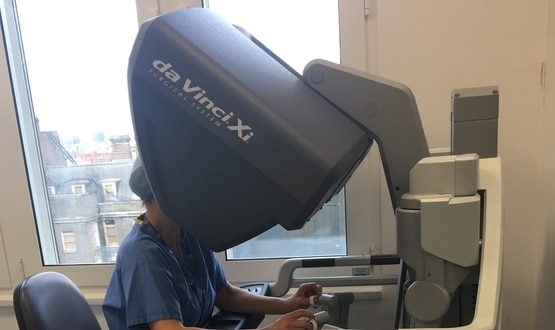Patients at The Royal London Hospital benefit from robot assisted surgery
- 18 April 2018

One hundred patients at The Royal London Hospital have befitted from robot assisted surgery since the technology was introduced in 2017.
Since November 2017, a Da Vinci Xi robot has been shared by surgeons from across five teams at the hospital which is part of Barts Health NHS Trust, including gynae-oncology, colorectal, erology, ear nose and throat (ENT) and hepatobiliary.
Surgeons operate the robot from a console positioned beside the patient, using their hands and feet to control the camera and small instruments inside the patient.
All teams started with simple surgical cases, gradually introducing more complex procedures.
The renal (kidney) transplant team also plan to join the robotic programme later in the year.
Elly Brockbank, chair of the hospital’s Robotic Users Group and consultant gynaecologist oncologist said: “I am delighted that robotic assisted surgery is proving such a success at Barts Health.
“It is rare to have so many different surgical teams at one hospital using the Da Vinci robot, and the smooth transition from simple to complex surgical procedures is due to the dedication of all staff involved. We are very much looking forward to the next one hundred cases.”
The Da Vinci robot was introduced at the hospital thanks to £5.5 million funding from Bart’s Charity.
The machines mean patients can be treated with minimally invasive surgery, with several small incisions made instead of one big cut.
Previously, some procedures may have been deemed too risky for patients. However, the robots allow for less blood loss, less pain, faster recovery and faster patient discharge.
The use of robots during surgery is becoming more popular.
Last week, Digital Health News reported on a double surgery performed using robots on a cancer patient at The Royal Marsden Hospital in London.
Surgeons sat on opposite sides of the Aa Vinci Xi robotic console to perform a hysterectomy on 63-year-old Christine Lockton, as well as remove part of her colon.





1 Comments
So for a 5.5M investment the benefits are…eh, small holes instead of 1 big one and maybe possible to operate on more risky patients – is that it? excuse me whilst I’m underwhelmed.
Comments are closed.